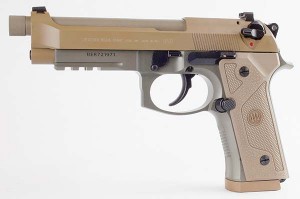by Joseph P. Tartaro | Executive Editor
Sometimes it seems that government agency decisions regarding firearms purchases are as confused as a newcomer to a gun show.
The FBI’s decision to go back to the 9mm Parabellum and the Army’s long-lived procrastination over a new sidearm are recent examples.
The FBI is returning to the ammunition caliber it labeled ineffective and blamed for the deaths of two of its agents during a 1986 shootout in Miami—the 9mm jacketed hollow point Luger, The Washington Post reported on Oct. 31.

The Beretta M9A3 claims features like a thin grip with a removable, modular wrap-around grip, MIL-STD-1913 accessory rail, removable front and rear tritium sights, extended and threaded barrel for suppressor use, a 17-round sand resistant magazine, and numerous improved small components to increase durability and ergonomics, all in an earth tone finish. Beretta USA offered the M9A3 to the US Army via an ECP in December 2014, prior to that Service’s decision to allow use of more lethal 9mm ammunition.
In addition to the new bullet, the newspaper reported, the FBI has decided to purchase a new pistol to fire it, something that could be in the hands of the FBI’s approximately 13,000 agents by 2016, according to bureau officials. The decision could also have far-ranging implications for local law enforcement agencies because they often model their procurement decisions on those made by the FBI.
The bureau dumped the 9mm bullet after the Miami incident because it failed to penetrate far enough into the gunman’s torso.
The shooter, former Army Ranger Michael Platt, then went on to kill two agents and wound a third. Though Platt was shot multiple times, an autopsy revealed that he died from the wound suffered from that first shot—one that penetrated his chest cavity but stopped just short of his heart.
In response, the FBI fielded a new pistol round: the 10mm. Complaints that the 10mm was too challenging for many agents, led to it’s being ditched in favor of the .40 S&W—essentially a 10mm Short. The stubbier .40 round could fit into smaller pistols.
Now, after recent studies on new 9mm rounds by the FBI’s Ballistic Research Facility, the 9mm is slowly finding its way back into the hands of police officers across the country.
According to FBI Special Agent Ray Cook, the current unit chief of the FBI’s Defensive Systems Unit, the bureau, which continuously tests various types of ammunition, began considering a return to the 9mm round in 2007 in part because of advances in ballistic technology, The Post said.
The new 9mm round is reported to be the 147-grain Speer Gold Dot G2. The Post said that according to Cook, the bullet has been rigorously tested and has received high marks in the FBI’s most important category for bullet selection: penetration.
Cook says that the lighter the bullet, the faster the gun can “drive” the round into the target. For the FBI, that translates into 12 to 18 inches of penetration into the human body.
At about the same time the FBI 9mm story broke, The Washington Times reported that Senate Armed Services Committee Chair John McCain (R-AZ) was preparing a report titled “America’s Most Wasted: Army’s Costly Misfire.”
The report says the Army has spent 10 years preparing a competition for a gun that will cost about $500. During all that time, he says, the Army has little to show but a thick, complex requirements package that perplexes gunmakers and may produce a rigged result.
“Worse, the Army may fail to field a handgun at all because of the way it has structured this weapon system acquisition,” says the upcoming report, a copy of which was obtained by The Times.
A battlefield survey by the Center for Naval Analyses found 46% of soldier respondents expressed unhappiness with the M9 because of malfunctions and high maintenance. Twenty-five percent reported stoppages, or jamming, during a firefight.
“The Army has managed to create entirely new acquisition problems for what should be a simple, straightforward purchase of a commercially available item,” says McCain, He concluded the Army simply does not know how to buy an off-the-shelf pistol.
As voluminous as the Army’s requirements—known as a request for proposal (RFP)—are, the 350 pages lack one critical guide to gunmakers: the caliber.
McCain’s report said this omission will make it impossible for some manufactures to compete.
“The caliber of the cartridge and the type of bullet it launches is arguably the most important performance component of the handgun,” he said. “One of the principles of a commercial off-the-shelf acquisition is that the government must be clear on what it is seeking to buy. This lack of clarity will likely result in top handgun makers not competing as many of them are not large defense contractors, which means that our soldiers won’t necessarily get the best handgun that commercial industry has to offer.”
The solution, McCain said, is to cancel the burdensome RFP, then make fast-track purchases of guns already evaluated and holstered by American special operations troops.
While the FBI’s return to the 9mm round and the Army’s pistol procurement problems were making news, Beretta Defense Technologies (BDT) announced that the Beretta Model M9A3 semi-automatic pistol is now shipping to law enforcement dealers and law enforcement agencies, and is currently being offered to military customers worldwide.
Built in the US, the M9A3 claims advances in pistol design and other enhancements that result in increased modularity, reliability, durability, and ergonomics.
“The M9A3 represents the next generation handgun utilizing the best attributes of the legacy M9 pistol combined with proven COTS modifications that increase performance and durability,” stated Gabriele dePlano, vice president of Military Marketing and Operations for BDT. Added de Plano, “The US Army, or any military or law enforcement service using M9s can adopt this weapon today with minimal impact to their training, in-service accessories (holsters, lights, etc.), integrated logistics support plan, and existing parts inventory.”



